< Previous
A PLEA FOR COWEN STREET
By Stephen Best
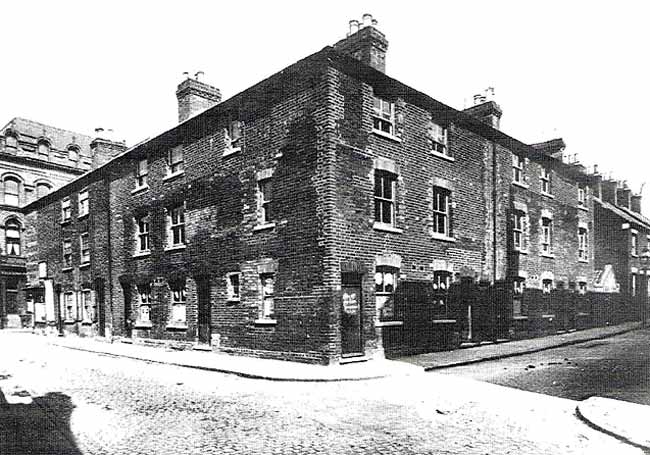 COWEN STREET (right), about 1912, looking from Brook Street. The Britannia PH is in the background. (Courtesy Nottinghamshire Local Studies Library).
COWEN STREET (right), about 1912, looking from Brook Street. The Britannia PH is in the background. (Courtesy Nottinghamshire Local Studies Library).
Though it lies on the edge of Sneinton Magazine's sphere of interest, a street off Bath Street, near the William Booth Memorial Halls, is worth a mention here.
For some years now, COWEN STREET, which links Brook Street and Bath Street, has exhibited name plates reading 'Cowan Street'. This small error is enough to obscure the origin of the name, which commemorates a family very prominent here for over a century. The restoration of correctly spelt signs is long overdue.
Originally called Pottery Street, in reference to Charles Morley's Beck Street pottery works, established in the eighteenth century, the thoroughfare was renamed Cowen Street soon after the Nottingham Borough Extension of 1877. Robert Cowen of Sheffield had come to Nottingham in 1818, shortly afterwards setting up the Beck Engineering and Ironfoundry Works in Beck Street. With one short gap, the Beck Works traded through the nineteenth century under Cowen's name. Around the year 1840, however, Robert Cowen was in partnership with William Bell, Orange's directory for that year listing the concern as Bell & Co., iron founders. Glover's directory of 1844 gives the name as Bell & Cowen; this directory is of special interest, as it includes an advertisement detailing a number of the firm's products, and depicting Bell and Cowen's retail warehouse at the comer of Thurland Street and Lincoln Street. This was a short-lived enterprise, the premises being by 1848 the shop of another iron dealer, Henry Ashforth. In later years, the building was well known as the premises of the celebrated ironmongers, Thomas Danks & Co. Ltd.
Robert Cowen lived close to the works, in Beck Lane, moving after retirement to Villa Road. His son George Roberts Cowen, perhaps the major figure in the firm, was educated at the old Grammar School in Stoney Street, before going into the family business. Becoming a partner in 1844, he remained active in the running of the firm until 1883, when he retired, leaving his two sons, Edward and George, as proprietors. In 1870 G.R. Cowen was elected a Member of the Institution of Mechanical Engineers. Further advertisements in local trade directories give more information about the firm's activities. In 1864 Cowen’s entry ran:- 'Iron and Brass Founders: cooking ranges: cotton preparing machines etc. Also Agents for Giffard's Patent Injector'. Four years later, Cowen's advert included mention of 'Steam Engines and Boilers: Hydraulic and Screw Presses’. Industries of Nottingham, published in 1889, a few years after G.R. Cowen's retirement, described how his firm, occupying 'an eligible site just off Brook Street', had 'advanced from a small concern into one of the first magnitude'. The volume also praised 'the splendid ability and unfaltering energy displayed in its management throughout', which contributed to Cowen's success at home and abroad.
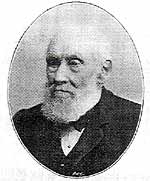 GEORGE ROBERTS COWEN, about 1900.
GEORGE ROBERTS COWEN, about 1900.A resident of the Ropewalk for over forty years, having earlier lived in Elm Avenue, George Roberts Cowen survived to a great age, dying in his ninetieth year in 1907. His other business interests included a directorship of the Wainfleet & Firsby Railway (promoters of the line to Skegness), which had in 1896 been bought out by the Great Northern Railway. G.R. Cowen had a fine record in public life. He was first elected to the Town Council in 1859, and also served as one of the Nottingham Board of Guardians, and on the committee of the Women's Hospital. His second wife Ann, who died in 1894, was equally noteworthy. A daughter of Thomas Guilford of Nottingham, she was for a time the only woman on Nottingham School Board, and was prominent as a member of the Women's Liberal Association, the Women's Suffragette Association, and the Ladies' Sanitary Association. Active in the organisation of Heathcote Street Women's Club, Mrs Cowen was a regular attender of High Pavement Chapel, where she was a Band of Hope worker. One of G.R. Cowen's successors in the firm, George Cowen (d. 1934) was a pioneer motorist in the town. He brought a motor car from Coventry to Nottingham in 1897; this was said to have been the first car ever seen here. Latterly a resident of Fox Road, West Bridgford, he was also interested in the construction of steam boats and launches, and was keen on sailing, as a founder member of Trent Valley Sailing Club.
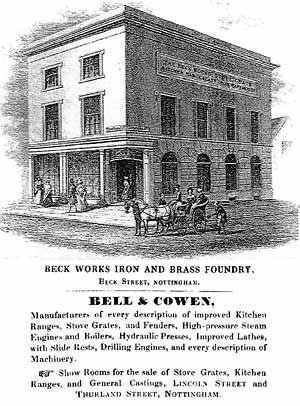 BELL & COWEN'S ADVERTISEMENT in the 1844 directory, showing the showroom at the corner of Thurland Street and Lincoln Street.
BELL & COWEN'S ADVERTISEMENT in the 1844 directory, showing the showroom at the corner of Thurland Street and Lincoln Street.In the Local Studies Library, Angel Row, can be seen a copy of a work of the other son, Edward Samuel Cowen (d. 1931), who lived in Peveril Drive, The Park, after his father's death. This is a curious pictorial diagram titled 'Some Nottingham landmarks and some county heights compared'. Dated May 2 1902, and signed 'E.S. Cowen', it lists altitudes of places in the county, from Newark church and market, 61 feet; to Pearl Hill, Coxmoor, 645 feet. The Nottingham landmarks drawn by Mr Cowen range from Trent Bridge, at 70 feet above sea level, to Mapperley brickyard, at 420 feet. Sneinton Windmill is depicted with its sail-less cap reaching an altitude of 250 feet.
Cowen's continued to run the Beck Works until the mid-1920s; the buildings were occupied thereafter by Barton Bros. Ltd., and then by the Newey Engineering Co., who moved out in the early 1960s. No trace of the works now exists; it was pulled down after Newey's departure, to be replaced by the Post Office premises which currently occupy the site. Cowen Street in 1993 is a glum and featureless place, lined on one side by the Post Office building, and presenting on the other nothing more exciting than a fenced British Telecom car park. Below this stand Social Services Department premises, formerly the public weighbridge offices.
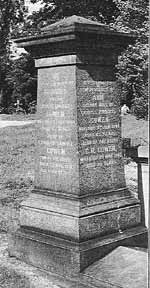 THE COWEN FAMILY MEMORIAL in Nottingham General Cemetery.
THE COWEN FAMILY MEMORIAL in Nottingham General Cemetery.There must still be people in Nottingham who can remember living in Cowen Street, which had houses along one side until the sixties. The incorrect version of its name has now spread to Nottingham street maps, so one hopes that the authorities will quickly restore the Cowen family name to the place named after them. Several prominent Cowens are commemorated on a tapering memorial of polished granite in Nottingham General Cemetery; standing at the edge of the main drive, close to the car parking area, it records the names of George Robert Cowen, his wives Harriet and Ann, and his son Edward Samuel.
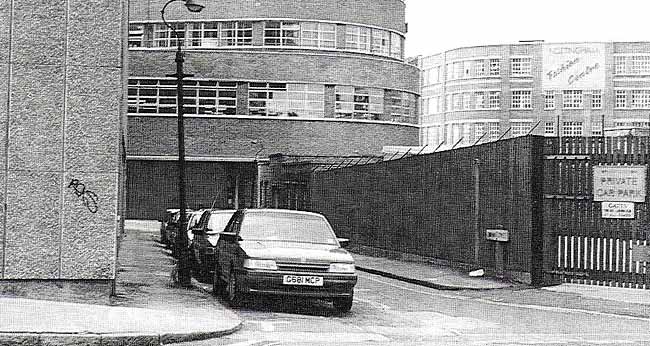 COWEN STREET from Bath Street, 1992.
COWEN STREET from Bath Street, 1992.If Cowen Street has fared badly, the nearby NILE STREET was, until very recently, treated in even more miserable a fashion. For more years than one could remember, this little thoroughfare, connecting Brook Street and Huntingdon Street, and flanked on both sides by Royal Mail buildings, had been bereft of all name plates, in spite of being correctly identified on some up-to-date street plans. With uncanny timing, the authorities put up street signs here just before a version of this present article went to press in the Nottingham Civic Society Newsletter, making necessary a hurried, last-minute footnote. Still one could hardly complain that one's wish had been so mysteriously carried out, and it was good to see Nile Street publicly identified. One now looks forward to a similar miracle in Cowen Street. No one nowadays has an address in either Nile Street or Cowen Street, so neither appears in the postcodes listed in the current Thomson directory. For all that, it would be pleasant if Cowen Street, like Nile Street, could display its right name.
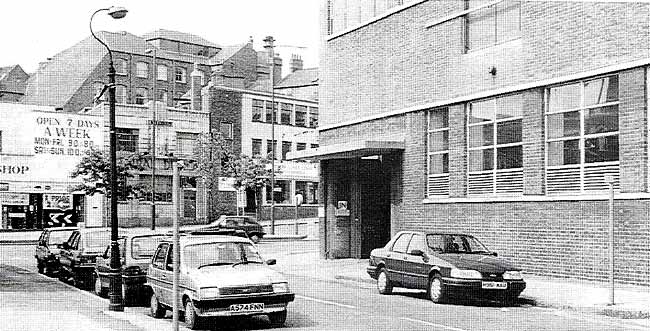 NILE STREET looking towards Lower Parliament Street, 1992.
NILE STREET looking towards Lower Parliament Street, 1992.ALL PHOTOGRAPHS, unless otherwise indicated, are by Stephen Best.
< Previous
